By Jeffrey A. Rendall, Photos by Kevin Gaydosh
PINEHURST, NC -- “This will either be the smartest thing I’ve ever done, or the dumbest,” remarked Pinehurst Resort owner Bob Dedman, upon deciding to go ahead with a complete restoration of the venerable Pinehurst 2 golf course, home to numerous championships and carrying the title of legendary architect Donald Ross’s masterpiece.
Not to mention the fact that Ross’s #2 Course is the driving force behind Pinehurst’s being known as “The Home of Golf” -- so even touching the layout must come with a considerable amount of trepidation.
(Note: Dedman made the remark to Bill Coore. The Coore & Crenshaw aspect of the story will be dealt with in a separate article.)
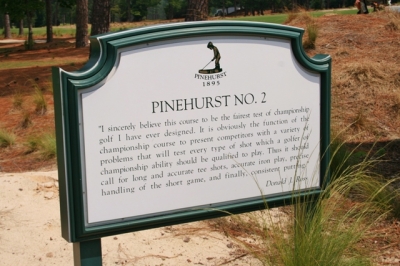 |
| Donald Ross may no longer be with us, but his words still greet every player before a round at Pinehurst 2. |
Nonetheless, touch it they did, and several years after the idea was hatched, the course has been restored to its former look and strategy. For those who have seen Pinehurst #2 over the decades on TV (as host of the ’99 and ’05 U.S. Opens, amongst others), you’ll hardly recognize it in its latest form – a metamorphosis so remarkable that it could only have a fascinating story to go along with it.
Luckily, Pinehurst’s long-time Manager of Grounds and Golf Course Maintenance, Bob Farren, sheds light on the tale. “It’s pretty simple, really, as to why there was talk about restoring the #2 course – it had kind of lost its identity, and some of the fabric of why it had become such an old classic golf course.”
He continues, “It had a great reputation obviously from the earlier to middle parts of the century from a lot of the championships – the North-South Opens and the North-South Championships. There was a great history. I’ve actually been at Pinehurst since 1982, and I could recall what the course was in those years of the early 80’s. We had some great championships on it and the two U.S. Opens were preceded by the Senior Open and the Tour Championships.”
Time and spatial considerations won’t allow for a full recounting of every famous event that’s ever been played on #2, but you get the idea. In American golf lore, the course can hold its own with any of the greats – and the fact that anyone can play it anytime they want (in the public sense) makes it all the more special.
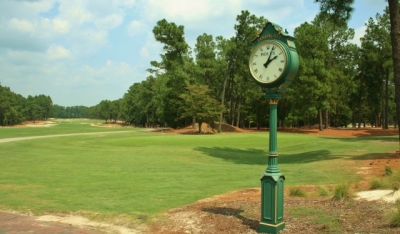 |
| Time may stand still at Pinehurst, but the No. 2 course has a completely new look. |
That’s not to say that the course we’ve been playing up until a few years ago was the same one that Ross laboriously sculpted and sweated over personally. The fact is, #2 hand changed dramatically since his day.
“The design of the course hadn’t really changed, it was just the way it’d been managed,” Farren elaborated. “I’m not ashamed or don’t regret any of the things we did going through those championships to prepare and present the course, as we felt like, one, the players wanted it that way and the market demanded them.”
Which essentially meant adding turf to the sides of the layout. And in order to green it up, you needed irrigation. Over the years, what had formerly been natural sandy areas with native vegetation became a sea of Bermuda grass, turning #2 into more of a parkland/park-like setting versus the Sandhills course that its original reputation was built on.
Modern golfers didn’t necessarily complain – after all, golf is played on grass (at least most of the time). And the golf market demanded pristine playing conditions – so when you’re going to a course and paying top dollar to do so, the average consumer wants every blade in place, so to speak.
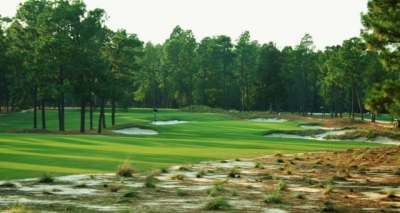 |
| The long 16th hole plays as a par four in the U.S. Open -- the rest of the time, it is a good chance to make a birdie as a par five for resort players. |
And those signature turtle-shell greens were always there, so it was still #2, right?
Not really. “Over the years, the way the course was maintained with all the turf started changing the strategy in which you play it – and I think that’s the key point,” Farren said. “At 22-28 yards wide, the fairways became so narrow that they were virtually unhittable (Bill Coore confirmed this). A lot of the time, people were spending valuable minutes looking for balls in the 2-2.5 inch Bermuda rough.”
“The number 2 course was still a favorite of people coming to Pinehurst, but it just wasn’t what it was meant to be. This is my personal opinion, but we went through the excess of the 80’s and 90’s with people just spending ridiculous amounts of money doing different things,” Farren speculated.
In other words, even Pinehurst #2 had gone extreme.
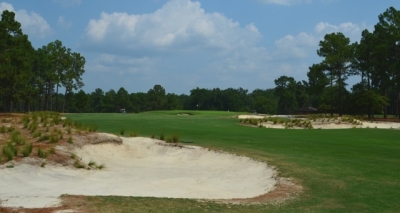 |
| The par four 3rd hole is not long, but you still must navigate the hazards off the tee to have a good shot at the green. |
So, the decision was made to change it back. Making the “go retro” process a bit easier was the fact that Pinehurst had added other courses that would keep the turf-lovers happy. The Tom Fazio-designed Pinehurst 8 had been built with a more modern, hard-lined and landscaped look (with defined bunkers), and Pinehurst 4 had also been renovated (again, by Fazio) to offer the same thing.
Conceivably, the #2 course could be brought back “to the past” without damaging the resort’s overall brand for offering the finest of golf experiences (in the manicured look) that people expect.
Once they decided to go ahead with Pinehurst #2’s restoration, the question became… what to restore it to?
“We started having discussions what to do in 2008 during the U.S. Amateur,” Farren remembered. “(USGA Executive Director) Mike Davis really had an interest in trying to incorporate more of the wiregrass and sandy areas back into play that had been lost over the years. But I don’t think any of us – myself for sure – realized then the extent that we would go. And I don’t even think Mike realized the commitment that we would have to make until we engaged Crenshaw & Coore in the summer of ’09.”
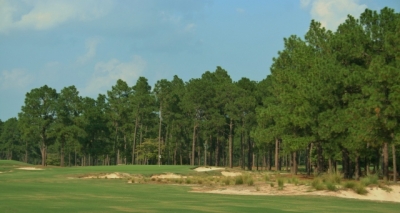 |
| Missing to the right is strongly discouraged on the long par four 12th hole. |
For anyone who’s seen C & C’s work, they would be a natural choice in working on the project. Their courses, from Bandon Trails in Oregon to Kapalua’s Plantation Course in Hawaii to Sand Hills in Nebraska – all of them lay appropriately on the land and literally look like they’ve been there forever. Not quite the hand of God, but a couple gentlemen with a good idea of what a golf course should look like.
And if anyone could summons Donald Ross, it was Ben and Bill – the latter having come from North Carolina and grew up playing Ross’s creations.
After the designers’ arrival, according to Farren, the group spent several visits discussing the “what if” philosophies with the resort’s leadership (Dedman and Pinehurst President Bob Padgett) as well as with Davis, going over the possibilities. “Okay, if we do this, will the course maintain its integrity for the U.S. Open (both the men’s and women’s events are set for Pinehurst 2 back-to-back in June, 2014)? We don’t want to get into changing it back when the time comes.”
Davis gave the assurance that it was okay to move forward from the USGA’s standpoint.
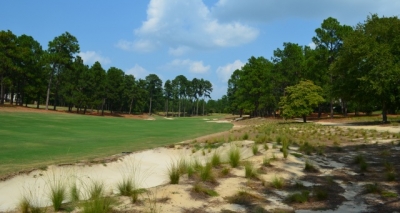 |
| The par five 4th hole is one of the best birdie chances on Pinehurst 2 for both professionals and amateurs alike. |
With the necessary approvals in hand from the management and the USGA, it was time to hit the library. Fortunately, a wealth of material regarding the “old” Pinehurst 2 was waiting in the Tufts archives, which made the process go a lot smoother. But it was an aerial photograph from 1943 that was the key to the project, Farren said (and this was also confirmed by Bill Coore).
Somewhat compounding the difficulty was the previous work that had been done to the course. With a layout as old as #2, it had already been renovated a number of times before. Farren said the greens had been completely rebuilt in 1986, installing drainage for the first time (they were rebuilt exactly as they were, with the same undulations).
The greens then underwent another re-do in 1996, with Rees Jones onsite as a consultant, getting the course ready to host the ’99 U.S. Open (which led to Payne Stewart’s famous putt on the 72nd hole that sealed his legend, four months prior to his death).
Jones’ job was mostly to add length to the course, so tees were repositioned and new ones built – but the greens were basically duplicated elevation-wise and undulation-wise exactly as they had been historically.
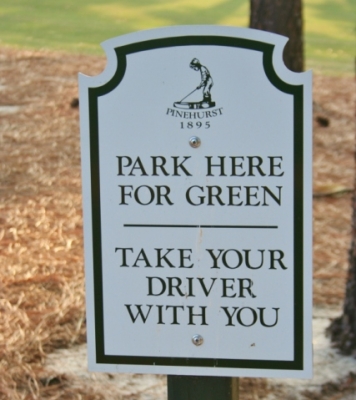 |
| Just because Pinehurst 2 was restored does not mean it is no longer friendly. Whether you want to bring your driver with you, however, is up to you. |
Likewise, the recent restoration largely left those domed greens as-is (though Farren said some minor tweaking was done on the 15th and 17th holes). But there was plenty of work to do from the greens back to the tees, which mostly involved getting rid of the Bermuda grass and bringing the Sandhills look back to the Pinehurst 2.
Construction began, and at least in the initial stages (starting in March, 2010), work went on while the course was still open. It gave the architects the ability to interact with the golfers, and the golfers a chance to have Ben Crenshaw watch them tee off – now that is pressure.
The “heavy lifting” in the project was done between November of 2010 and March of 2011, when the resort closed the famous layout for its restoration. And unlike other projects that Farren had witnessed (that basically just lengthened the holes), this one impacted everyone.
Between 35-40 acres of turf was removed, it turns out. As noted before, the vast majority of the grass that was eliminated was in the form of thick Bermuda rough. And the turf that remains is now cut to fairway height – you may not realize it at first, but the average fairway width has nearly doubled to 40 to 45 yards.
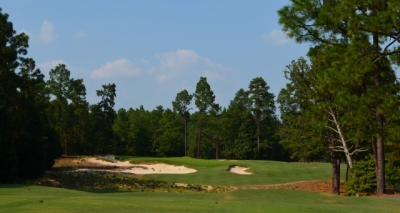 |
| The par three 9th hole is simple enough in concept - but playing it is quite another matter. |
It takes some mental adjustment to remember that the fairways are actually wider than they were before – because with the rough all gone, there’s a lot of sand out there.
You’ll have no trouble seeing #2 as a Sandhills course now. No joke.
To be fair, a couple gentlemen who joined us for our trip around the restored legendary course found a lot of that sand – and to them, it wasn’t like a day at the beach. They were both long-hitting mid-handicappers, and consistently drove it through the fairways (from the white tees) into the natural areas.
It’s clear that the “new” #2 is going to require some period of adjustment for those who are used to seeing wall-to-wall grass. And it might even require a different way of thinking about which tee box you should be playing from, starting with the first tee.
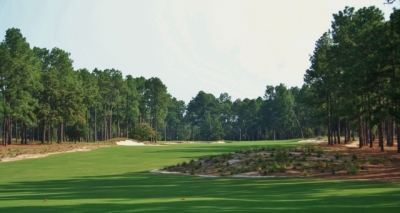 |
| At 619-yards, the par five 10th hole is the longest on the course. |
“We don’t usually have the problem of people hitting the ball too far,” Farren remarked. “But if they’re hitting it 240-260 from the white tees, they’re essentially playing the fairway corridor that the championship will be played on. The fairways become narrower from 290-330 yards from the championship tees – a smaller target for the professionals and better players to force them to think off the tee, and bottom line, be more accurate.”
True enough, the fairway widths short of the fairway bunkers on #2 certainly present an inviting target. But if you’re beyond them – and you don’t like sand – watch out.
There’s more. “I’ve found two things in playing with members who are mid-handicappers,” Farren explained. “One, everyone’s in the short grass a lot more often now than when the fairways were only 26 yards wide. Secondly, when the ball goes into a sandy area – it may be sand hardpan, it might be against a wiregrass clump – I can count on one hand the number of times where it’s actually been unplayable and had to basically chip away from it.”
Farren’s right – the ball is much easier to find in the sand (which speeds up play) and you usually can advance it. The hardpan sand isn’t a shot that a lot of us are used to playing, but there’s little doubt that it’s easier than chopping it out of dense Bermuda rough with a long-iron.
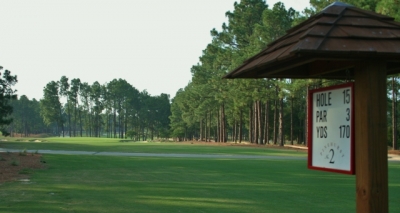 |
| The par three 15th hole looks benign until you miss the green -- and then it is a very difficult up and down. |
It’s just a different way of playing golf – one that has a lot of appeal, if you buy in to the concept. Not all golf courses were meant to be parkland-style, and certainly that’s true of a classic like #2.
For all its quality, Farren admits that the restored #2 is not quite the same as the course Donald Ross left behind after passing in 1948 – but in some respects, it’s much better.
Heresy? Not exactly. “The conditioning level of the turf that’s there, the tees and fairways and certainly the greens – is far beyond anything he would’ve envisioned, that would’ve ever been possible at that time.”
“When I speak to different golf groups of people, they understand that we have all this new technology from the equipment and balls standpoint, but what a lot of folks don’t take into consideration are the turf conditions that people play on now compared to what they were even 20 years ago.
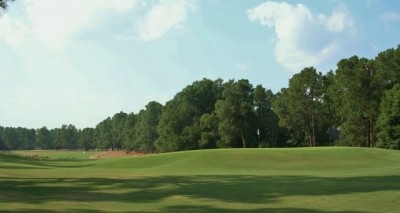 |
| The slope in the back of the green of the long (490-yards) 8th hole really is that severe. Do not go long. |
“The putting surfaces are far better, far faster, far smoother, far more predictable and consistent. And the fairways as well. Compared to what they were in Donald Ross’s day, but even more recent than that,” Farren added.
The work may have been completed in 2011 (with the course opening March 4th), but Pinehurst 2’s looks will continue to evolve, due to the emergence of native plant species in the “unfinished” areas.
“We have to be selective in the ones that we want to have grow, and the ones we don’t want to have grow. And it’s a seasonal thing -- some of the plants are different in the spring than they are in the summer. So you can play it once a month for a full year, and it won’t be the same each time you play it. Each time, it’ll be a little different,” Farren said proudly.
It’s hard to imagine how a course that’s as “old” and “new” as Pinehurst 2 could continue to evolve and change, but that’s probably the greatest thing about a golf layout that’s not only stood the test of time – it’s now better than ever.
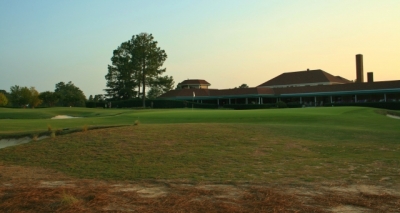 |
| The sun sets on another day at Pinehurst 2, but you know the 18th green will have many, many more good ones in the future. |
Pinehurst 2 always was a “must play” for true aficionados of golf architecture: and now the urgency’s been stepped up a notch. It’s great to see a course that’s a classic play as one – an experience you certainly will never forget.
Where We Stayed – The Lodges at Mid South
Staying at Pinehurst Resort is a special experience by itself, but for our last trip, we chose a place nearby that offered all the comforts of home – and a darn nice home at that.
General Manager (of Talamore and Mid South) John McDougald explains the thinking behind the Lodges at Mid South – which were just about the complete package when it comes to taking golf “on the road.”
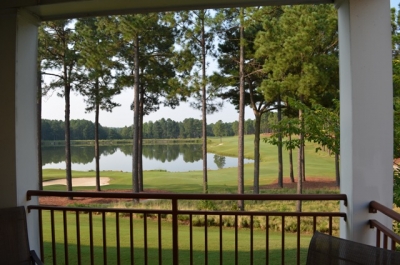 |
| The view from the deck of the Mid South Lodges is as beautiful as the inside. |
“Talamore Golf partners… when we came to the area in the early 90’s, one thing we didn’t want to do was impact our neighbors. We didn’t want to try and challenge what Pinehurst does, because they do it extremely well. We didn’t want to do what Pine Needles does – they do a wonderful job.
“We wanted to have our own niche. And we found our niche to be condos as opposed to hotel rooms. We found our niche to be, people staying with us, cooking their own food or going to dinner, making it more of a longer term, more permanent, kind of a ‘stay.’
“It’s a wonderful thing, and some of our greatest growth of late has been long-term stays. As we get into the fall, it’s Canadians and people in the northeast who aren’t able to retire for whatever reason and are taking the opportunity to come down for month at a time, and enjoy the area and have accommodations that are comfortable to the point where you can live in them without concern.”
Without concern is an understatement. The condos are extremely well appointed with Jacuzzi tubs, full kitchens (with stainless steel appliances, no less), more-than-generous living areas and tiled floors.
You won’t want to go home. As if the golf wasn’t great enough, the Lodges at Mid South will make you love the Pinehurst area even more.
For more information on the Lodges at Mid South, consult the website: http://www.talamoregolfresort.com/
Details:
Pinehurst Resort
1 Carolina Vista Drive,
Village of Pinehurst, NC
Phone: 800-487-4653
Website: www.pinehurst.com
Facebook.com/PinehurstResort
Pinehurst 2 Tees/Yardage/Slope/Rating
U.S. Open 7495 141/76.4
Blue 6930 136/73.8
White 6307 130/70.7 141/76.9 (W)
Green 5822 126/68.2 133/73.8 (W)
Red 5267 129/70.2
Packages:
The Pinehurst Golf Package starts at $389 spring and $289 summer and includes accommodations, round of golf and breakfast. You can see more here: http://www.pinehurst.com/golf-packages/pinehurst-golf-package
| Related Links | Comments on this article? | |
|
Maryland National Golf Club Hollow Creek Golf Club Rocky Gap Resort PB Dye Golf Club in Ijamsville Whiskey Creek Golf Club |
E-mail Jeff Rendall, Editor: jrendall@golftheunitedstates.com |











